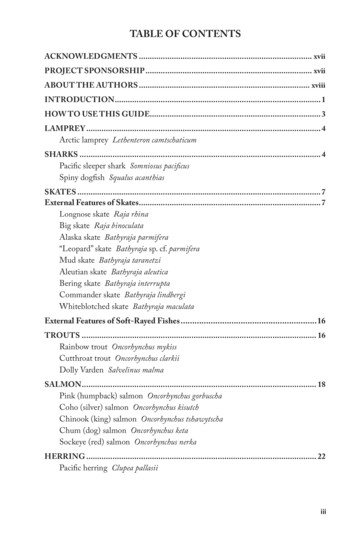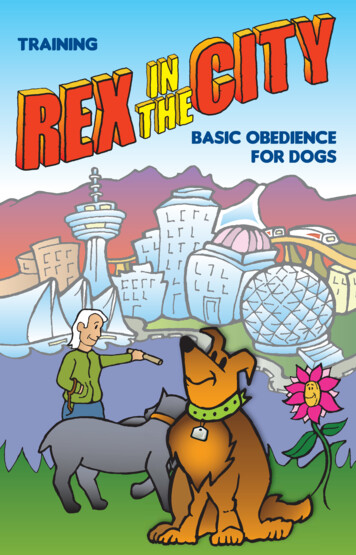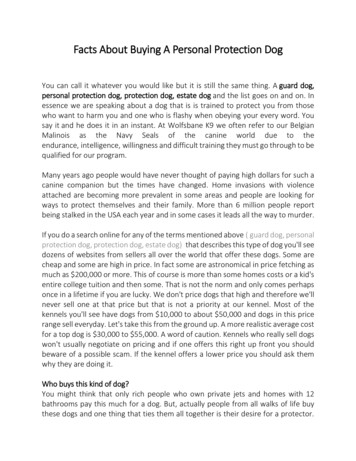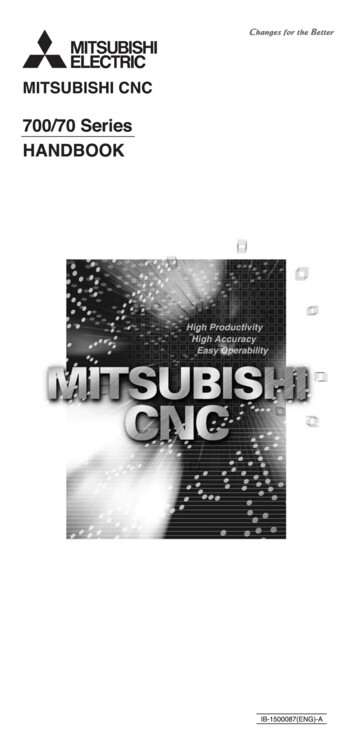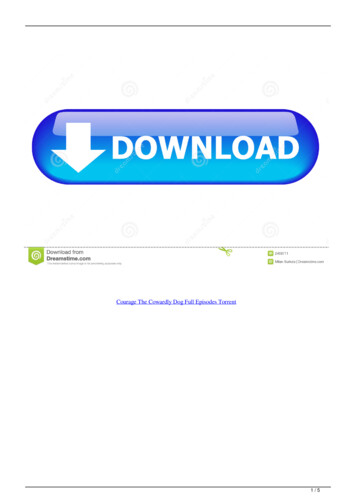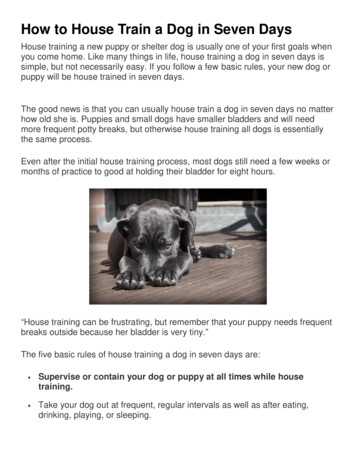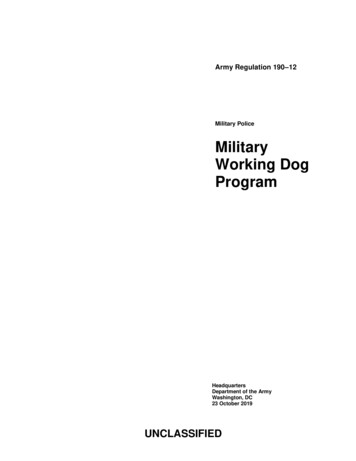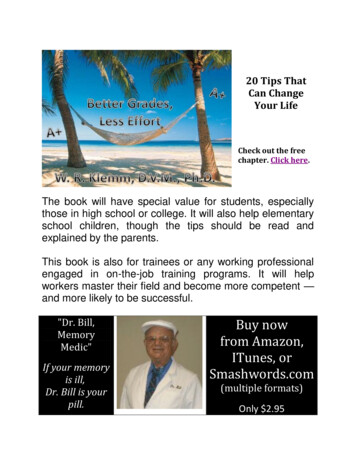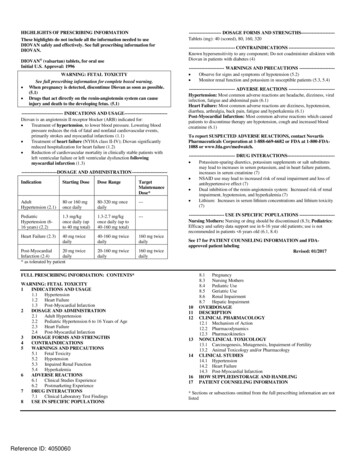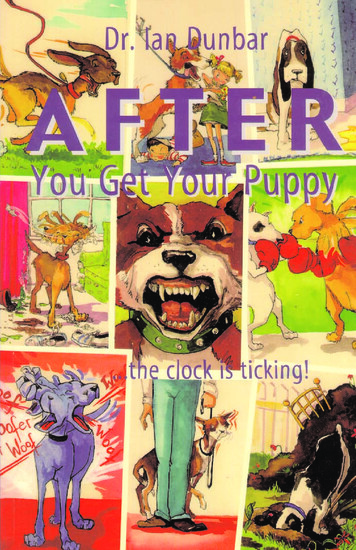
Transcription
AFTERYou Get Your PuppyDr. Ian DunbarFree eBook Courtesy of:Enter Your Business Name& Contact Information HereWith Permission From the Authorand www.JamesAndKenneth.comJames & KennethP U B L I S H E R S
Dr. Ian Dunbar and Omaha BeagleAFTER You Get Your Puppy 2001 Ian DunbarFirst published in 2001 by:James & Kenneth Publishers2140 Shattuck Avenue #2406Berkeley, California 947041-800-784-5531James & Kenneth—UKCathargoed Isaf, Golden GroveCarmarthen, Dyfed SA32 8LY01558-823237Printed in the United States of AmericaAll rights reserved. Except for brief quotationsused in reviews, no part of this publicationmay be reproduced in any form without thewritten permission of the publisher.IBSN 1-888047-01-1
ContentsChapter OneDEVELOPMENTAL DEADLINES.5The Most Urgent Priority .6The Most Important Priority.7The Most Enjoyable Priority .8Chapter TwoHOUSEHOLD ETIQUETTE 101 .9When You Are Not at Home.9When You Are at Home.11Housetraining 1-2-3 .12Common Mistakes .13Chapter ThreeHOME ALONE .15Separation Anxiety.17When Leaving Home.19When Returning Home .19Jekyll-and-Hyde Behavior .20Chapter FourSOCIALIZATION WITH PEOPLE .23Urgency.24A Hundred People.25Three Goals of Socialization .271. Teach Your Puppy to Like People .28Training Treats .29Willing Compliance .31Children .32Puppy-Party Games.35Men and Strangers.37Sit to Say Hello .38Teasing and Roughhousing .39Handfeeding .432. Handling and Gentling.44Hugging/Restraint .46Calming Quickly .47Tantrums .48Alpha Rollover?.48Handling/Examination.49Punishment .53Grabitis .57"I Ate My Dog's Homework".60Barking and Growling on Cue .67Outrageous Silliness.693. Guarding Valued Objects.70The Token System.72The Food Bowl.75The Delinquent Waiter Routine.77Paper Tissue Issues! .78Chapter FiveLEARNING BITE INHIBITION .79Good Bite Inhibition .80Case Histories .81Dog Bites: Bad News and Good News .83Human Bite Inhibition? .86Bite Inhibition with Other Dogs .88Bite Inhibition with People.89Bite Inhibition Exercises.90Inhibiting the Force of Bites .90Decreasing the Incidence of Mouthing .92Out-of-Control Play Sessions .95Puppies with Soft Mouths.96Puppies That Don't Bite.96A Big Mistake .97Puppy School .98The Ultimate Reason for Puppy Classes .101Health Risks.103Carry Your Puppy .105Looking for a Puppy Class .108Chapter SixADOLESCENT PROBLEMS .109Changes During Adolescence .110Manners, Bite Inhibition, Socialization .110Fighting .112The Secret to Adolescent Success .116The Dog Walk .119Housetraining on Walks.120Socializing on Walks .123Training on Walks.123Sit and Settle Down .127Training in the Car.130Training in the Dog Park .131Come When Called.133Emergency Distance Sit.134Integrate Training and Games.137Lifestyle Training.139Chapter SevenHOMEWORK SCHEDULES .142Chapter EightSHOPPING LIST/BOOKS & VIDEOS .149
CHAPTER ONEDevelopmental DeadlinesCongratulations! So, you have your new puppy. Nowwhat? Basically, you are at a fork in the road. Thesuccess of the relationship depends on your teachingyour puppy the rules and regulations of domestic living. Themost critical time in your dog's life is right now—puppyhood!First impressions are indelible and long-lasting. Consequently,the next few weeks are crucially important for your dog'sdevelopment. Help and guidance at this stage will have aprofound and everlasting effect that will enrich the dog-humanrelationship for many years to come.BEFORE You Get Your Puppy addressed your puppy's firstthree developmental deadlines: your doggy education; thesearch for and selection of a suitable puppy and how to assessits developmental status; and teaching household mannersduring your puppy's first week at home. The first threedevelopmental deadlines were extremely urgent, crucial, andleft precious little room for mistakes. In view of theirimportance and tight deadline, household manners will besummarized here. AFTER You Get Your Puppy will focus onyour puppy's next three developmental deadlines during thefirst three months your puppy is at home.The clock is still ticking, and you only have three months toget a lot of things done.www.dogstardaily.com5
AFTER YOU GET YOUR PUPPYThe Remaining ThreeDevelopmental DeadlinesThe 4th Developmental DeadlineSocialization with PeopleThe Most Urgent Priority—by 12 weeks of ageThe 5th Developmental DeadlineLearning Bite InhibitionThe Most Important Priority—by 18 weeks of ageThe 6th Developmental DeadlinePreventing Adolescent ProblemsThe Most Enjoyable Priority—by five months of ageThe most urgent priority is to socialize your puppy to a widevariety of people, especially children, men, and strangers,before he is twelve weeks old. Well-socialized puppies grow upto be wonderful companions, whereas antisocial dogs aredifficult, time-consuming, and potentially dangerous. Yourpuppy needs to learn to enjoy the company of all people and toenjoy being handled by all people, especially children andstrangers.As a rule of thumb, your puppy needs to meet at least ahundred people before he is three months old. Since your puppyis still too young to venture out on the streets, you'll need tostart inviting people to your home right away. Basically, you'llneed to have lots of puppy parties and invite friends over tohandfeed your pup and train him for you.www.dogstardaily.com6
DEVELOPMENTAL DEADLINESThe most important priority is that your puppy learns reliablebite inhibition and develop a soft mouth before he is eighteenweeks old. Whenever a dog bites a person or fights with anotherdog, the seriousness of the problem depends on the seriousnessof the injury. Hence, the ease and success of retraining dependsalmost entirely on the dog's degree of bite inhibition. Thereliability of your dog's bite inhibition determines whether youhave a minor problem which may be easily corrected with a fewsafe, basic training exercises, or whether you have a serious andpotentially dangerous problem which is going to be extremelydifficult to resolve.In a perfect world, you will successfully socialize yourpuppy so that he thoroughly enjoys the company and actions ofall people, all dogs, and all animals. More realistically, though,accidents happen. Someone accidentally shuts the dog's tail inthe car door. Someone runs to answer the telephone andaccidentally treads on a sleeping dog's leg. A child runs andtrips and falls on top of the dog while he is gnawing on a bone.When dogs are hurt or startled, their natural response is to snap,lunge, and even bite. Even wonderfully friendly dogs may feelinclined to protect or defend themselves when picked on byother dogs and people.For example, when hurt or frightened a dog may snap andlunge at a person. But if a dog has well-established biteinhibition it is unlikely his teeth will even touch the skin. Or ifthere is skin contact, it is unlikely that the teeth will break theskin. The dog has caused no damage and the potentially seriousproblem has been easily and safely prevented. If, on the otherhand, the dog has inadequate bite inhibition and his teethpuncture the skin, then you have a serious situation which maybe difficult and time-consuming to resolve.www.dogstardaily.com7
AFTER YOU GET YOUR PUPPYSimilarly, dogs with well-established bite inhibition nevercause damage when fighting with other dogs. The problem isminor because your dog is simply squabbling in a sociallyacceptable manner. On the other hand, if your dog ever hurtsanother dog or another animal, you have a major problem andresolution is unlikely.Bite inhibition must be established in puppyhood, beforeeighteen weeks of age, since it is difficult to instill biteinhibition in an adolescent or adult dog. Learning the skills andtechniques to ensure your puppy develops a reliable biteinhibition and an ultra-soft mouth is the primary reason for youto attend off-leash puppy classes. Your puppy needs to playwith other puppies. Playing with adult dogs at home or in thepark is simply not sufficient.The most enjoyable priority of dog ownership is to accustomyour well-socialized, soft-mouthed puppy to the world at largeand prevent the development of predictable adolescentproblems, thus assuring that he remains well-socialized andsoft-mouthed. Remember, your dog will only remain sociable ifhe continues meeting and greeting unfamiliar people andunfamiliar dogs every day. Meeting the same people and dogsover and over is not sufficient. You want your dog to practicethe art of meeting and getting along with strangers, not simplygetting along with old friends. Consequently, regular walkswith your dog are as essential as they are enjoyable.Your life is about to change. You are about to experience allthe joys of dog ownership—long, energetic, or relaxing walks,trips in the car, afternoons in the dog park, picnics on the beach,plus so many enjoyable organized doggy activities.Before we address socialization, bite inhibition, and walkingyour dog, let's review your puppy's household manners.www.dogstardaily.com8
CHAPTER TWOHousehold Etiquette 101It is vital that you have taught your puppy where toeliminate, what to chew, and how to happily enjoy the timewhen left at home alone. Moreover, it is essential that yourpuppy's schooling continue forever.If your puppy is having housesoiling or chewing problems,reread BEFORE You Get Your Puppy and seek help immediately.Any mistake is a potential disaster because it signals many moremistakes to come. It is important that housetraining and chewtoytraining are errorless. Do not stray from the puppy confinementprogram. The more quickly you housetrain your puppy, thesooner she will get to enjoy free run of your house.When You Are Not at HomeKeep your puppy confined to a fairly small puppy playroom(long-term confinement area), for example, in the kitchen,bathroom, utility room, or section of the room cordoned off byan exercise pen. Include a comfortable bed, a bowl of cleanfresh water, plenty of hollow chewtoys (Kong products andsterilized bones stuffed with dog food), and a doggy toilet in thefarthest corner from her bed.The purpose of a long-term confinement area is twofold:1. To prevent mistakes around the house2. To maximize the likelihood that your puppy will learn touse the provided toilet, to chew only chewtoys (the onlychewables available), and to settle down calmly andquietly (without barking)www.dogstardaily.com9
AFTER YOU GET YOUR PUPPYWhenever you are away from home, leave your puppy in her playroom.A suitable long-term confinement area needs a waterproof (easy-toclean) floor, a comfortable bed, a bowl of fresh water, some chewtoysstuffed with kibble, and a toilet. If you leave your puppy in thebathroom, remember to put the towels, bath mat, shower curtain,and toilet paper out of reach.Remember, any housesoiling or chewing mistake is apotential disaster because it predicts many more to come. If ayoung, uneducated puppy is ever allowed unsupervised free runof the house, housesoiling and chewing mistakes are inevitable,and the puppy will more likely become hyperactive andanxious. Confinement prompts the pup to focus on her stuffedchewtoys, leaving her little time to fret, worry, or bark. Ofcourse, once your puppy has mastered household manners andenjoys her time spent at home alone, she may enjoy full run ofyour house and yard at any time you wish.www.dogstardaily.com10
HOUSEHOLD ETIQUETTE 101When You Are at HomeIt is important to supervise your puppy. When the two of youare not play-training, confine your pup for an hour at a time toher doggy den (short-term confinement area), such as a portabledog crate. Include a comfortable bed and plenty of stuffedchewtoys.Short-term confinement to a crate has many advantages: it prevents yourpuppy from making mistakes around the house; maximizes the likelihood thepup will develop a chewtoy habit; and facilitates housetraining becauseyou may now accurately predict when your puppy needs to relieve herself.If your puppy chews her bed, remove it for a couple of days until the pup hasbecome fixated on chewtoys.www.dogstardaily.com11
AFTER YOU GET YOUR PUPPYThe purpose of short-term confinement is threefold:1. To prevent mistakes around the house2. To teach your puppy to become a chewtoyaholic (sincechewtoys stuffed with food are the only chewablesavailable), so that she learns to settle down quickly,quietly, and calmly3. To be able to predict when your puppy needs to eliminateClosely confining a puppy to her bed strongly inhibitsurination and defecation, so she will be in dire need to relieveherself when released from the crate each hour. Being able toaccurately predict when your puppy needs to eliminate enablesyou to be there to teach her where to eliminate, and to rewardthe pup for doing the right thing in the right place at the righttime.Housetraining Is as Easy as 1-2-3When you are away from home, keep your puppy confinedto her puppy playroom, where she has a suitable doggytoilet. Otherwise, when you are at home:1. Keep your puppy closely confined to her doggy den,or on-leash by her bed.2. Every hour on the hour, release your pupfrom confinement and quickly run her (on-leash ifnecessary) to the toilet area. Instruct your pup toeliminate and give her three minutes to do so.3. Enthusiastically praise your puppy, offer her threefreeze-dried liver treats, and then play/train indoorsor in the yard. (Once your puppy is over three monthsold, take her for a walk as a reward for eliminating inher toilet area.)www.dogstardaily.com12
HOUSEHOLD ETIQUETTE 101Common Mistakes1. Allowing your puppy to make a mistake.And why did the pup make a mistake? Let's askher teacher. Who left the puppy with a fullrectum and full bladder unattended in thebedroom? Who left the empty puppy unattendedto ransack the living room? Who allowed theuntrained puppy to be home alone with free runof the house? Please go back and reread thepuppy confinement schedule. Your puppy'sconfinement schedule ensures that your pup'shousehold education continues even when she isleft at home alone. Errorless housetraining andchewtoy training is just so simple.2. Not rewarding your puppy for getting it right.You didn't praise your pup or offer any tastytreats, and now you wonder why your puppydoesn't do what you want her to do. It is hardlyyour puppy's fault that she feels free toimprovise her doggy toys and toilets. Please goback and reread the puppy confinementschedule. Stuff those chewtoys with kibble andthe occasional treat. And always profusely praiseand reward your puppy for doing the right thingin the right place at the right time.www.dogstardaily.com13
AFTER YOU GET YOUR PUPPYHome Alonewww.dogstardaily.com14
CHAPTER THREEHome AloneAll owners find it occasionally necessary to leave theirpuppydog at home alone. So before leaving your puppyfor long periods, you should teach him how to amusehimself appropriately when left alone, such as by chewingstuffed chewtoys, and learning how to enjoy his own companywithout becoming anxious or stressed. A dog is a highly socialanimal and therefore requires adequate preparation forspending some of his time in social isolation and solitaryconfinement.To teach your puppy how to settle down calmly and quietlywhen you are absent, start by teaching him to settle down witha chewtoy at times when you are present.A dog is not like a television or a video game. You can't justpull the plug or temporarily remove the batteries from arambunctious puppy. Instead, you must teach him to settledown and shush. Right from the outset, make frequent quietmoments part of the puppy's daily routine. Following theconfinement schedule (described in the previous chapter) willhelp your puppy train himself to settle down. Additionally,encourage your puppy to settle down beside you for longer andlonger periods. For example, when you're watching televisionhave your pup lie down on leash or in his crate, but release himfor short play-training breaks during the commercials. For ayoung puppy, you can't have too many rules.When playing with your pup, have him settle down forfrequent short interludes every one or two minutes. Initiallywww.dogstardaily.com15
AFTER YOU GET YOUR PUPPYhave the pup lie still for a few seconds before letting him playagain. After a minute, interrupt the play session once more witha three-second settle-down. Then try for four seconds, then five,eight, ten, and so on. Although being yo-yoed between thecommands "Settle down" and "Let's play" is difficult at first, thepuppy soon learns to settle down quickly and happily. Yourpuppy will learn that being asked to settle down is not the endof the world, nor is it necessarily the end of the play session, butinstead that "Settle down" signals a short timeout and rewardbreak before he is allowed to resume playing.If you teach your puppy to be calm and controlled when told,you will have years of fun and excitement ahead. Once yourpuppy has learned to settle down and shush on cue, there is somuch more your dog can enjoy with you. Your well-trained dogis likely to be invited for many walks, trips in the car, picnics,visits to the pub, or to Grandma's, and even on incredibleSince Claude was an anxious soul and a big-time destructive chewer,for the first ten days after adoption he was fed kibble only from chewtoysplaced in his chewtoy basketwww.dogstardaily.com16
HOME ALONEjourneys to stay in ritzy dog-friendly hotels. On the other hand,if you let your dog play indiscriminately as a puppy, he will nodoubt want to play indiscriminately as an adult. Your dog willbe hyperactive and uncontrollable because you have taught himto act that way. If your pup has not been taught to settle downby the time he reaches adolescence, he will be unfit to be takenplaces. Your pup will begin a lifetime of confinement andisolation at home while the rest of the family go out to have agood time. Not fair!Until you have trained your puppy to enjoy spending muchof his day at home alone, you might recruit a puppy sitter whohas time to spend with him. Just a few houses down the street,there may live an elderly gentleman, for example, who wouldjust love to live with a dog (but who doesn't for some reason)and therefore would be willing to come over during the daytimeand sit and enjoy your TV or the contents of your fridge;maintain your puppy's confinement schedule and regularlyreward him for using his doggy toilet; and periodically playwith the pup and teach him household rules.Separation AnxietyMaintaining your puppy's confinement schedule when you areat home prepares your puppy to be calm when you are gone.Allowing a young puppy unrestricted access to you when youare at home quickly encourages him to become overlydependent, and overdependence is the most common reasonwhy dogs become anxious when left at home alone.Try your best to teach your puppy to enjoy his own company,to develop self-confidence, and to stand on his own four paws.Once your puppy is confident and relaxed on his own, he mayenjoy all of his time with you when you are at home.www.dogstardaily.com17
AFTER YOU GET YOUR PUPPYWhen leaving your puppy for hourly sessions in his shortterm confinement area (dog crate), make a point to check howhe fares when left in another room. For example, periodicallyconfine your puppy to his crate in the dining room while youprepare food in the kitchen, then keep the pup in his crate in thekitchen while the family eats dinner in the dining room.Most importantly, when you are at home, make certain tofamiliarize your puppy with his long-term confinement area(puppy playroom). Confining your pup when you're homeenables you to monitor his behavior during confinement andcheck in on him at irregular intervals, quietly rewarding him forbeing quiet. Thus your pup will not necessarily associate hisconfinement area with your absence, but rather he will learn tolook forward to time spent in his playroom with his special toys.Give your puppy plenty of toys whenever leaving him on hisown. Ideal chewtoys are indestructible and hollow (such asKong products or sterilized longbones), as they may beClaude Konged—peacefully passing the time when left at home alone(after chewing himself to sleep)www.dogstardaily.com18
HOME ALONEconveniently stuffed with kibble and occasional treats whichperiodically fall out and reward the pup for chewing his toy. Ifyour puppy is gainfully occupied with his chewtoy, he will fretless over your absence.Additionally, leave a radio playing. The sound willprovide white noise to mask outside disturbances. The soundof a radio is also reassuring, since it is normally associatedwith your presence. My Malamute Phoenix was quite partialto Classical music, Country, and Calypso. Oso preferstelevision, especially ESPN or CNN—the sound ofreassuring male voices, perhaps?When Leaving HomeMake sure to stuff a number of chewtoys with kibble and treats.Make sure to stuff a piece of freeze-dried liver into the tiny holeof each Kong, or deep into the marrow cavity of each bone.Place the tastily stuffed chewtoys in your puppy's long-termconfinement area and shut the door . . . with your puppy on theoutside! When your puppy begs you to open the door, let him inand shut the door, turn on the radio or television, and leavequietly. Your puppy's chewing will be regularly reinforced byeach piece of kibble which falls out of the chewtoy. Your puppywill continue to chew in an attempt to extract the freeze-driedliver. Eventually your puppy will fall asleep.When Returning HomeDo not acknowledge your puppy's presence with praise orpetting until he retrieves a chewtoy. Once he brings you achewtoy, use a pen or pencil to push out the piece of freezedried liver which your puppy has been unable to extract. Thiswill impress your puppy to no end.www.dogstardaily.com19
AFTER YOU GET YOUR PUPPYDogs are crepuscular and quite happy to sleep all day and allnight. They have two activity peaks, at dawn and dusk. Thus,most chewing and barking activity is likely to occur right afteryou leave your pup in the morning and just before you return inthe evening. Leaving your puppy with freshly stuffed chewtoysand offering the unextracted treats when you return promptsyour puppy to seek out his chewtoys at times of peak activity.Jekyll-and-Hyde BehaviorSmothering your puppy with attention and affection when youare home primes the pup to really miss you when you are gone.A Jekyll-and-Hyde environment (lots of attention when you arethere, and none when you are gone) quickly creates a Jeckylland-Hyde puppy which is completely confident when you arethere, but falls apart and panics when you are gone.If you allow your puppy to become dependent upon yourpresence, he will be anxious in your absence. Canine anxiety isbad news for you and bad news for your pup. When stressed,Wonderful Weekendsand Worrisome WeekdaysWhereas weekend attention and affection is wonderful, itprimes your new puppy to miss the family on Mondaymorning when the parents go to work and the children leavefor school. By all means, play with and train your puppylots during the weekend, but also have lots of quietmoments to prepare your puppy for lonely weekdays.www.dogstardaily.com20
HOME ALONEMany supposed signsof separation anxietyare really signs of aninsufficiently traineddog being allowedunsupervised freerange of the houseand encounteringtemptation left bytheir owners.dogs are more likely to indulge in bad habits, such ashousesoiling, chewing, digging, and barking. Being anxious isalso decidedly unpleasant for your dog.During your puppy's first few weeks at home, frequentconfinement with stuffed chewtoys is essential for yourpup to develop confidence and independence. Once yourpuppy is quite happy busying himself with his chewtoyswhenever left alone, you may safely allow your now wellbehaved and confident pup to enjoy as much time with youas he likes, without the fear that he will become anxious inyour absence.www.dogstardaily.com21
AFTER YOU GET YOUR PUPPYIs It Really Separation Anxiety?Most doggy "disobedience" and wanton house destructionoccurring in the owner's absence has nothing to do withseparation anxiety. In fact, separation relief might be a moreprecise and descriptive term. The dog chews, digs, barks, andsoils the house only when the owner is absent because he haslearned it would be foolhardy to indulge in these pastimes whenthe owner is present. Owner-absent misbehavior is anindication that the owner has tried to suppress normal andnatural dog behaviors with punishment, rather than teaching thedog how to behave—namely, how to express his basic doggydesires in an acceptable fashion. Often the term separationanxiety is an excuse for a dog who is simply not yethousetrained or chewtoy-trained.Beagles just begging to "unpack" a visitor's unattended luggagewww.dogstardaily.com22
CHAPTER FOURTHE FOURTH DEVELOPMENTAL DEADLINESocialization with People(By Three Months of Age)Raising and training a pup to be people-friendly is thesecond most important goal of pet-dog husbandry. Remember,teaching bite inhibition is always the most important goal. Butduring your pup's first month at home, urgency dictates thatsocialization with people is the prime puppy directive.Your puppy must be fully socialized to people before he isthree months old. Many people think puppy classes are the timeto socialize puppies to people. Not so. It's too little, and too late.Puppy classes are a fun night out to continue socializingsocialized puppies with people, for therapeutic socialization ofpuppies with other puppies, and most important, for puppies tolearn bite inhibition.You now have just a few weeks left to socialize your puppy.Unfortunately, your pup needs to be confined indoors until he isat least three months old, when he has acquired sufficientimmunity through his puppy shots against the more serious dogdiseases. However, even a relatively short period of socialisolation at such a crucial developmental stage could all but ruinyour puppy's temperament. Whereas dog-dog socialization maybe put on temporary hold until your pup is old enough to go topuppy school and the dog park, you simply cannot delaysocialization with people. It may be possible to live with a dogwww.dogstardaily.com23
AFTER YOU GET YOUR PUPPYthat does not like other dogs, but it is difficult and potentiallydangerous to live with a dog that does not like people, especiallyif the dog doesn't like some of your friends and family.Consequently, there is considerable urgency to introduceyour puppy to a wide variety of people—to family, friends,strangers, and especially men, and children. As a rule of thumb,your pup needs to meet at least a hundred different peoplebefore he is three months old—an average of three unfamiliarpeople a day.UrgencyFrom the very first day you get your puppy, the clock is ticking.And time flies! By eight weeks of age, your puppy's CriticalPeriod of Socialization is already waning and within a month,his most impressionable learning period will start to close.There is so much to teach, and nearly everything needs to betaught right away.Be SafePuppies may become infected with serious dog diseases bysniffing the urine or feces of infected dogs. Never let yourpuppy on the ground where other dogs may haveeliminated. You may take your puppy for car rides and tovisit friends, but always carry your puppy from house tocar, and vice versa. Of course, these precautions also applyto visits to the veterinary clinic. The ground immediatelyoutside the door of the clinic and the floor of the waitingroom are two of the most likely contaminated areas. Carryyour puppy from the car to the clinic and keep him on yourlap in the waiting room. Better yet, keep your puppy cratedin your car until it is tim
weeks old. Whenever a dog bites a person or fights with another dog, the seriousness of the problem depends on the seriousness of the injury. Hence, the ease and success of retraining depends almost entirely on the dog's degree of bite inhibition. The reliability of your
